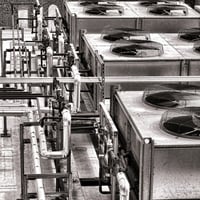Recent January wildfires in California have highlighted what has become an undeniable reality:...
How HVLS Fans Control Exposure to Hazardous Hydrogen Sulfide Gases
Many facilities have processes that pose a risk to the health and safety of their employees. Hazardous hydrogen sulfide gases (HS2) in dense concentrations can seriously affect employee health and safety. Facility managers must pursue corrective action well before their employees have been exposed to these chemicals. It’s important for facility managers to know all available options to control exposure to hydrogen sulfide gases. Their job is to find the solution that best fits their facility. HVLS fans present a simple solution to reduce employee exposure to hazardous hydrogen sulfide gases.
Employee Health and Safety
According to OSHA, some people who breathed in levels of hydrogen sulfide high enough to become unconscious continue to have headaches and poor attention span, memory, and motor function after waking up. Problems with the cardiovascular system have also been reported at exposures above permissible exposure limits. People who have asthma may be more sensitive to hydrogen sulfide exposure. That is, they may have difficulty breathing at levels lower than people without asthma.
Owners and managers of food processing plants, manure storage operations, and livestock facilities need 24/7 solutions, especially where filtration and groundwater treatment are not practical or sufficient.
Solution for Food Processing Plant
As a gas in high concentrations, hydrogen sulfide (HS2) is flammable and poisonous to humans and animals. So, owners and managers of plants, operations, and facilities need 24/7 solutions, especially where filtration and chemical counter-treatments are not practical or sufficient.
For example, a well-known food processor has two locations in Arkansas. In their operations, employees off-load chicken parts onto conveyor systems. For their own protection, the workers wore gas meters to signal when there was too much exposure to hydrogen sulfide fumes.
Managers found themselves taking 25 employees away from the linework every week because of the exposure. Those workers might be off for one to five days before they could safely return to work. Obviously, the company process was inviting problems for their employees' well-being and productivity.
Following the installation of High Volume Low Speed (HVLS) fans, the number of affected employees dropped to four per week.
Similar studies have found positive results in dairy and swine facilities.
How HVLS Fans Control Exposure to Hazardous Gases
HVLS fans move large masses of air. While their purpose is to move the air, cooling, aeration, and ventilation are major benefits.
- HVLS fans reduce hydrogen sulfide levels and control exposure.
- Grounded, HVLS are non-sparking and eliminate the potential for explosion.
- HVLS fans are corrosion-resistant
- Once installed an HVLS fan can create thermal equalization in facilities. This thermal equalization can save you as much as a 20% reduction in energy spending.
- HVLS fans—with their broad blade span, aerodynamic engineering, minimal horsepower, and digital “brains”—consume little energy and reduce the load on HVAC systems.
Facility managers must make worker health and safety a priority on a job site. This is especially important when processes create harmful hydrogen sulfide gases. In many vulnerable facilities, worker safety protocol results in a decreased workforce. This is because employees must be pulled off the line to avoid the risk of high exposure.
Summary
It’s the responsibility of the facility managers to control exposure to harmful hydrogen sulfide gases. Workers' health and safety must be protected while on the job site. In many food processing facilities, ensuring workers’ safety results in decreased productivity. Strategically placed HVLS fans will disburse and change the air to mitigate your risk and save costs in terms of power usage, lost time, and safety compliance. Facility managers who incorporate HVLS fans into their facilities are making a smart, cost-effective, and necessary move.

